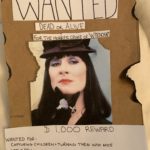Emma Stubbs
Artistic Representation Essay
History 333
Dana Wessell-Lightfoot
June 8 2020
The Witches Film Artistic Representation
I chose to base my artistic representation off both the film “The Witches” directed by Jim Henson and the children’s novel by Roald Dahl. The story line of this film and novel brings light to the role of witches historically, as well as focuses on the themes of feminism and female criminality in the sixteenth century across Europe.
I chose to represent the Grand High Witch from the film in a wanted poster which would have been present in the sixteenth century when most witch trials were occurring. I chose to combine the modern witch character with a historical setting to draw the correlation from the film and historical events. Due to witchcraft being a large focus of female criminality in the sixteenth and seventeenth centuries, I chose to represent a wanted poster for the crime of witchcraft. In this time wanted posters and pamphlets would have been a very successful way of communicating to the general public, as many could barely read. The large, simple text of a wanted poster would make it clear to all audiences what the person on the poster is wanted for. I chose to draw my image to best represent how the wanted poster would have been produced historically. I chose to take a humorous perspective to shed light to the dramatized perspective from the children’s novel and film. The crimes the Grand High Witch is wanted for is not historically accurate, but it is what the film portrayed as evil. I also used the location and description used in the film to give my wanted poster accuracy in regard to the film.
In the film “The Witches” there is a “Grand High Witch”- the head witch who is responsible for initiating hunts for children to turn them into mice. The Grand High Witch controls the actions of many other withes, therefor if there were to be a trial based on the context of the film, she would be the guiltiest out of all the witches due to her amount of power. The Grand High Witch does not have a name in the film, removing a sense of familiarity. The witch in the film is supposed to have an element of mystery and uncertainty, just like the historical role of witches. The main character in the film is a young boy named Luke. Luke is first introduced to ideas about witches and witchcraft by his grandmother, who warns Luke of witches who live amongst them. The grandmother warns Luke that witches look just like everybody else in society. The grandmother explains that you can tell which person is a witch because witch’s have square feet, bald heads and pointy noses. The description provided by the grandmother is an example of modern interpretation of what a witch was expected to look like. Luke and his grandmother end up staying in a hotel where a conference is occurring with over two hundred witches in attendance, and Luke ultimately ends up sneaking inside the conference room to get a better understanding of witches. Luke ends up being detected by the witches’ strong sense of smell towards children, and ultimately ends up being turned into a mouse by a magic potion.
This is where the film differs from the historical representation of witches, as witches did not actually have a magic potion used to turn children into mice. However, there is a strong analogy used in the film which is representative of the accusations of women as witches. Because the witches in the film hate children, this alludes to a disregard to the predominant role of women historically, as women were expected to possess maternal roles in society and therefore should not hate children. As well, Luke is a male protagonist which provides an interesting correlation to the historical role of witchcraft. Most authorities responsible for the persecution of witchcraft would have been male, and in the film, it is Luke who at the end of the story saves everybody from the evil witches. The role of a child protagonist is also alluding to the historical “imagination” that drove much of the witchcraft trials . The witch hunts relied heavily on a certain level of belief in witchcraft as it was not always about clear concise evidence to prove a witch guilty. But if the courts could believe that the actions of an accused woman constituted as witchcraft or suspicion of witchcraft, then the charges most times went through.
In my primary and secondary sources, there were many incidents where historical and modern representations of witchcraft overlapped. In the article “The Divels Speciall Instruments: Women and Witchcraft Before the Great Witch-Hunt” it was believed that in the sixteenth and seventeenth centuries, tensions between religious, social and economic changes created a “means of recreating the male status quo in the emerging social order” and that malice and supernatural powers were increasingly seen as female attributes . Women naturally obtained a lesser role in society compared to men and were often linked to accusations of witchcraft due to their vulnerability and susceptibility in poverty . These socio-economic factors impact how the modern image of witchcraft was created, as society generally pictures a witch as a woman with ragged dirty clothes, unhygienic and unattractive, all which historically were images of poverty.
These sources also referenced the shift in men’s perceptions of women at this time, and witchcraft trials reflected the shift toward a more misogynistic attitude socially . The accusations of witchcraft ultimately enforced patriarchy in society and created a lesser position in society for women, especially those accused of being a witch. Witchcraft was not the only crime being tried against women, but it did have the most profound effect on female inequality at this time. Witchcraft was the only “new” crime that was punishable by death, so the criminalization of women had a wider range of anti-social behaviour and had more serious implications for men than for women .
In the article “Criminalization, Decriminalization and Elite Attitudes to Witchcraft in England c.1563-1736: A Preliminary Survey” different crimes and charges the courts brought forward were discussed. This article helped shape the kinds of charges the witch in my wanted poster could be charged with. This is another example of how the historical representation differed from the modern film representation as the “types” of witchcraft or actions framed as witchcraft differed. The article talks about how modern perceptions of witchcraft make it seem like an extraordinary crime worthy of extreme punishment, but in the courts at that time it was treated equally as many other less serious crimes . As well, not every act of witchcraft had a malicious intent behind it.
Overall, the modern and historical representations of witches and witchcraft both share a same vein of feminism and female criminality as well as still contributes to gender stereotypes to this day. Certain images of witchcraft and witches, although often dramatized in films such as “The Witches” have remained similar whether it is being perceived in the modern or historical realm.
Works Cited
Barstow, Anne Llewellyn. “On Studying Witchcraft as Women’s History: A Historiography of the European Witch Persecutions.” Journal of Feminist Studies in Religion 4, no. 2 (1988): 7-19. Accessed May 16, 2020.
Braddick, Michael J. “State Formation in Early Modern England, C. 1550-1700”. Cambridge University Press, 2000. 1-281.
Henson, Jim. The Witches. DVD. Directed by Nicolas Roeg. United Kingdom: Warner Bros. Pictures, 1990.
Jones, Karen, and Zell, Michael. “The Divels Speciall Instruments’: Women and Witchcraft before the ‘Great Witch-Hunt’.” Social History 30, no. 1 (2005): 45-63. Accessed May 16, 2020. www.jstor.org/stable/4287161.
Karlsen, Carol F. “Salem Revisited.” The William and Mary Quarterly, Third Series, 65, no. 3 (2008): 489-94. Accessed May 17, 2020. www.jstor.org/stable/25096810.
Sharpe, J.A. “Criminalization, Decriminalization, and Elite Attitudes to Witchcraft in England c. 1563-1736: A Preliminary Survey.” IAHCCJ Bulletin, no. 17 (1992): 15-28. Accessed May 16, 2020. www.jstor.org/stable/43658118.
“The Confessions of Witches in Guersey, 1617”. Witchcraft Sourcebook. 2003. Milton: Taylor & Francis Group. Accessed May 16, 2020. ProQuest E Book Central.
“The Salem Witchcraft Trials, 1692”. Witchcraft Sourcebook. 2003. Milton: Taylor & Francis Group. Accessed May 16, 2020. ProQuest E Book Central.
Writing Details
- Emma Stubbs
- June 7, 2020
- 1353
 This work by Emma Stubbs is licensed under a Creative Commons CC-BY Attribution 4.0 International License.
This work by Emma Stubbs is licensed under a Creative Commons CC-BY Attribution 4.0 International License.- flickr photo by Lívia Cristina https://flickr.com/photos/liviacristinalc/3402221680 shared under a Creative Commons (BY-NC-ND) license
- Tweet

